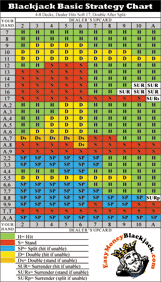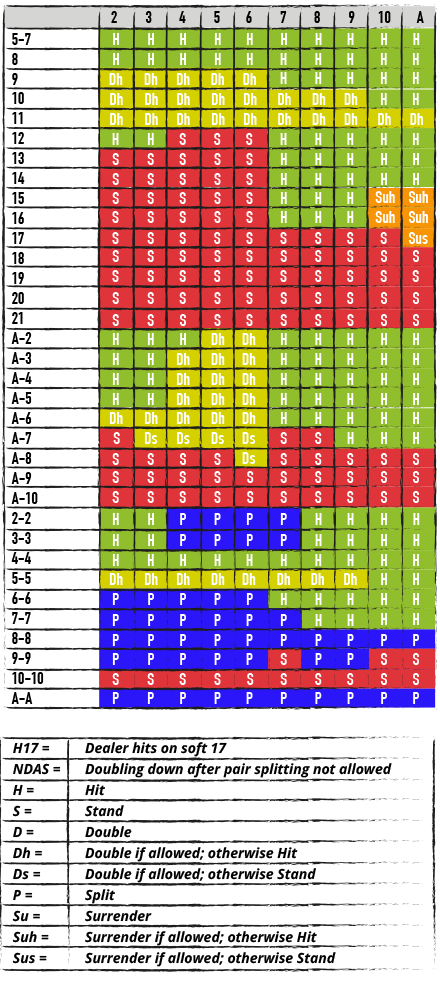Blackjack Strategy Das
Blackjack basic strategy: 6 decks, S17, DAS, No surrender, European. These are the rules of the blackjack game I used to play almost on a daily basis before the introduction of the automatic shuffling machines. Every new player, who wanted to play “correctly”, had to memorize the following Blackjack chart. Blackjack should need no introduction. It is the most popular table game in the United States, and is easily found in casinos throughout the world. The object of the game of Blackjack is simply to get more points than the dealer without going over 21. Rules Hand Signals Wizard’s Simple Strategy Basic Strategy Blackjack FAQ.
101217 - 21 Ace, 4 - Ace, 5 Ace , 7Pair A,A or pair 8,8 4,49,9Never take insurance or even money| Below 9 | hit (always) |
| 9 | Double Down when dealer shows 3-6 otherwise hit |
| DD except 10 and Ace otherwise hit | |
| 11 | DD except Ace |
| Stay 4-6 otherwise hit | |
| 13 - 16 | Stay 2-6 otherwise hit |
| Stay (always) | |
| Ace, 2 - Ace, 3 | DD when dealer shows 5, 6 otherwise hit |
| DD 4,5,6, otherwise hit | |
| Ace, 6 | DD 3-6 otherwise hit |
| Stay 2,7,8, DD 3-6 hit 9, 10, Ace (most misplayed hand in blackjack) | |
| Ace, 8 -Ace, 10 | Stay (always) |
| Split (always) | |
| 2,2 - 3,3 - 7,7 | Split 2-7 otherwise hit |
| Split 5,6 otherwise hit | |
| 6,6 | Split 2-6 otherwise hit |
| Split except dealer shows Ace, 7,10 | |
| 10,10 | Stay (always) |
Click here to purchase the above table. Credit card size and made of sturdy plastic - 3 for $0.99 cents
Some casinos allow blackjack tables to be used openly, others don't. When playing online keep this table at your side.

Daniel is now selling some Basic Strategy T-shirts in his store. The Basic Strategy chart is upside down on the front of the T-shirts. One glance down will remind you how to play your next hand.
The back is right-side up for your neighbor. Oh, and note the cool basic strategy coffee mug.
| These T-shirts have proven to be instant ice-breakers! It will make you the center of attention. Great for meeting people and oh, it will help your game. |

You have an Ace and 7, the dealer shows a 6. What do you do?
If you didn't immediately say Double Down, you need this T-shirt.
Don't have time to study basic strategy? Daniel's got you covered.Click to go to Daniel's store
Blackjack Strategy Test
Play and practice for free

Practice is the key to success in all fields. Several students that I have trained to become professional players all used this practice method. It simulates game-like conditions. First copy or purchase the basic strategy chart found above and keep it by your side. Click on the link to go to 888Casino. Click free download. A page of standard regulations will appear. Read and click agree. Choose a currency. You will receive a user name and password. Save them. This all should take a minute or two.Now click on play for free. That's it. You can practice all you want at no cost. Go at the speed you are comfortable with. Leave and return whenever you desire.
Blackjack Strategy Dash
Test yourself. Play 20 hands without looking at the chart. Click on history and the hands you just played will appear in a neat column. Go down the column while checking it against the chart. Not only are you learning but is great fun at no cost.
The above basic strategy is generic and serves me well for all games. The gain from learning a slightly different strategy for single and multi-deck is so minimal that it is not worth the effort.
That said I offer the following:
If Surrender is available: Sr 16 vs dealer 9'10'A Sr 15 vs dealer 10 | If DAS, double after splitting, is not permitted: do not split 6,6 vs dealer 2 do not split 4,4 vs dealer 5 or 6 do not split 3,3 vs dealer 2 or 3 do not split 2,2 vs dealer 2 or 3 What are you doing playing a game that does not allow DAS anyway? | In a single deck game stand on 7,7 vs dealer 10 and stand if you draw out 4,5,6 to a dealer 10 The above should be obvious in that you have used up the cards that could help you. You are in a bad situation and it is best to hope for the dealer to bust. |
Well now that you have seen basic strategy it is important to learn it. To learn anything it is easier if you understand it and believe in it. I don't want to go too deep into the details but the following explaination may help you see some of the reasons for the above basic stratgey chart.
Players have the most trouble with the A, 7 vs dealer 9, 10, A.
An 18 appears to be a pretty good hand and many people are reluctant to hit it. They reason why possibly ruin a good hand. The answer is that it is not a good hand against those dealer cards.
Look at a dealer 9. There are 13 possible cards under that 9. The ace gives the dealer a 20 and four chances for a 10 gives the dealer a 19. So right at the start you have lost five times. A 9 gives you a push and only an 8 a win. So with seven possible cards you have five losses, one tie and one win.
It gets more complicated now. If the under card is a 2 the dealer has an 11 with four chances of drawing a 10, one chance each at a 9 and 8 which beat your 18. In short the dealer will make good hands on about half of his draws resulting in the player losing 7.5 times, pushing once and winning only 3.5 times.
Now let's hit your A, 7 as basic strategy requires. An ace, 2 or 3 improves your hand and a 10 leaves it the same. If you draw a 6 for example and make a 14 you can hit again. You will make a good hand on about half of those draws. In summary look at the following table.
| If you fail to hit A,7 vs dealer 9 your loss is | |
| If you fail to hit A,7 vs dealer 10 your loss is | -4.00% |
| If you fail to hit A,7 vs dealer A your loss is |
If you fly on an airplane, cross a bridge or ride an elevator you trust the math. Winning blackjack is all about math. Trust it. Hit your A, 7 vs dealer 9, 10, A.
On This Page
Introduction
To use the basic strategy, look up your hand along the left vertical edge and the dealer's up card along the top. In both cases an A stands for ace. From top to bottom are the hard totals, soft totals, and splittable hands. There are two charts depending on whether the dealer hits or stands on soft 17.
Other basic strategy rules.
- Never take insurance or 'even money.'
- If there is no row for splitting (fives and tens), then look up your hand as a hard total (10 or 20).
- If you can't split because of a limit on re-splitting, then look up your hand as a hard total, except aces. In the extremely unlikely event you have a pair of aces you can't re-split and drawing to split aces is allowed, then double against a 6, otherwise hit.
If you play a mixture of six-deck games, some where the dealer hits a soft 17, and some where he stands, and you only wish to memorize one strategy, I would recommend you memorize the one where the dealer stands on soft 17. The cost in errors due to playing the wrong strategy is 2.3 times higher playing a stand on soft 17 game, with the hit on 17 strategy, than vise versa.

Basic Strategy in Text
For the benefit of my blind readers, here is the above strategy in text form, when the dealer stands on soft 17 and surrender is allowed. To use the strategy, start at the top, and follow the first rule that applies.
Surrender
- Surrender hard 16 (but not a pair of 8s) vs. dealer 9, 10, or A, and hard 15 vs. dealer 10.
Split
- Always split aces and 8s.
- Never split 5s and 10s.
- Split 2s and 3s against a dealer 4-7, and against a 2 or 3 if DAS is allowed.
- Split 4s only if DAS is allowed and the dealer shows a 5 or 6.
- Split 6s against a dealer 3-6, and against a 2 if DAS is allowed.
- Split 7s against a dealer 2-7.
- Split 9s against a dealer 2-6 or 8-9.
Double
- Double hard 9 vs. dealer 3-6.
- Double hard 10 except against a dealer 10 or A.
- Double hard 11 except against a dealer A.
- Double soft 13 or 14 vs. dealer 5-6.
- Double soft 15 or 16 vs. dealer 4-6.
- Double soft 17 or 18 vs. dealer 3-6.
Hit or Stand
- Always hit hard 11 or less.
- Stand on hard 12 against a dealer 4-6, otherwise hit.
- Stand on hard 13-16 against a dealer 2-6, otherwise hit.
- Always stand on hard 17 or more.
- Always hit soft 17 or less.
- Stand on soft 18 except hit against a dealer 9, 10, or A.
- Always stand on soft 19 or more.
As I've said many times, the above strategy will be fine under any set of rules. However, for you perfectionists out there, here are the modifications to make if the dealer hits a soft 17.
- Surrender 15, a pair of 8s, and 17 vs. dealer A.
- Double 11 vs. dealer A.
- Double soft 18 vs. dealer 2.
- Double soft 19 vs. dealer 6.
My thanks to Kelly for putting together the above text strategy.
Written by:Michael Shackleford